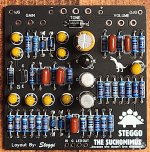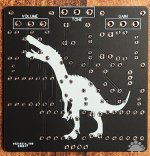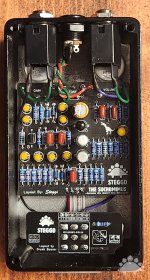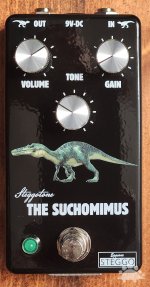Fingolfen
Well-known member
- Build Rating
- 5.00 star(s)
A little over a year ago I finished up a build of a really high gain and doomy Big Muff variant, Frantone's The Sweet. I had used a hand etched board from Effects Layouts and it came out pretty good overall. It sounded pretty much like all of the demos I found online. I'd tried to etch a couple more boards, but ran into some issues with my resist. Fast forward a few months and I'm learning to lay out my own boards. I figured something like this would be good practice as it is a bit more detailed than most of the early ones I'd been working on. So I got cracking and came up with my own PCB - no etching required!

Any time you validate a PCB, there's always some concern that you will have missed something, or laid something out wrong. Unfortunately this particular design takes a couple of unusual and a bit hard to come by transistors - NTE103's. Since I didn't know whether it was going to work out of the gate, I was tempted to use sockets for the transistors, but I'd had bad luck with those in the past, so I decided to go ahead and solder them in - carefully - with as long a remaining lead as I felt I could get away with. I also decided to go with a 2N3565 to put something slightly lower gain into Q4 to see if I could get the circuit to be a bit less doomy (I'd previously used a 2N5088 per Effects Layouts' suggestion). The gain of the 2N3565 I used was in the 160 Hfe range, so I may still try to go lower.
For the rest of the build I'm using mostly new components. There are several film capacitors (I even used metal film for the 330pF ones), but most of the capacitors are 1uF. I decided to go with tantalum capacitors in this particular build to have another point of comparison between the two builds. In fact the only electrolytic I used was the 100uF power supply filter capacitor. I'd accidentally purchased a very large number of 100uF 50V electrolytic capacitors that are a bit too big for a lot of my builds, so I'm using them in my own layouts.

As you can see from the image of the populated board at the top of the article, I really like adding a few Easter Eggs to the PCB. This one only had room for a few, but there is a suchomimus hiding between the 2N3565 and a 10uF tantalum capacitor. Most of my PCBs will also have the tagline "...because who doesn't like dinosaurs?" on them somewhere as well. Also, as you can see from the image above, the fun doesn't stop on the face of the PCB - there's usually something on the back as well. Will these ever be seen once the pedal is assembled? Most likely not. However, I do enjoy adding them as it makes the builds a ton of fun for me.

The rest of the build is pretty straightforward. I'd set up this board very much like a PedalPCB board with the 9V DC coming in at the top of the board and both of the audio jacks grounded to the PCB as well. The connection between the main PCB and the 3PDT daughter board is also very similar to a PedalPCB build apart from the fact that the LED is on the daughter board for this build as opposed to the main board. I decided to go with a green diffused LED on this build rather than a gold / yellow largely so I could tell at a glance which pedal had the the etched board versus the manufactured PCB build.

The enclosure is exactly the same one I used before (I'd had a couple made up in the original run), so the knob layout didn't perfectly match the new board, but it was close enough with a few minor bends. While I love the dinosaur, there are a few too many "derivative" touches on this particular enclosure. If I ever decide to make more (and I do have a few more PCBs lying about) I'll likely update the enclosure art quite a bit to something a bit more purely "Steggo".
Sound-wise it's very much like my previous build - loud, brash, and doomy. Even dropping the gain on Q4, it still feels a bit overloaded to me - though that's what all of the demos of the real thing seem to sound like as well. That sort of makes the pedal a one trick pony. Given I have the boards, I'm thinking about taking this basic design back to the breadboard and messing with the transistors, diodes, and some of the other values to see if I can find something with a little more range. I'd still like it to get into "doom" territory, but I'd like it to make a few stops along the way!
Original blog entry: https://steggostudios.blogspot.com/2024/02/revisiting-old-bmp-variant-with-new.html

Any time you validate a PCB, there's always some concern that you will have missed something, or laid something out wrong. Unfortunately this particular design takes a couple of unusual and a bit hard to come by transistors - NTE103's. Since I didn't know whether it was going to work out of the gate, I was tempted to use sockets for the transistors, but I'd had bad luck with those in the past, so I decided to go ahead and solder them in - carefully - with as long a remaining lead as I felt I could get away with. I also decided to go with a 2N3565 to put something slightly lower gain into Q4 to see if I could get the circuit to be a bit less doomy (I'd previously used a 2N5088 per Effects Layouts' suggestion). The gain of the 2N3565 I used was in the 160 Hfe range, so I may still try to go lower.
For the rest of the build I'm using mostly new components. There are several film capacitors (I even used metal film for the 330pF ones), but most of the capacitors are 1uF. I decided to go with tantalum capacitors in this particular build to have another point of comparison between the two builds. In fact the only electrolytic I used was the 100uF power supply filter capacitor. I'd accidentally purchased a very large number of 100uF 50V electrolytic capacitors that are a bit too big for a lot of my builds, so I'm using them in my own layouts.

As you can see from the image of the populated board at the top of the article, I really like adding a few Easter Eggs to the PCB. This one only had room for a few, but there is a suchomimus hiding between the 2N3565 and a 10uF tantalum capacitor. Most of my PCBs will also have the tagline "...because who doesn't like dinosaurs?" on them somewhere as well. Also, as you can see from the image above, the fun doesn't stop on the face of the PCB - there's usually something on the back as well. Will these ever be seen once the pedal is assembled? Most likely not. However, I do enjoy adding them as it makes the builds a ton of fun for me.

The rest of the build is pretty straightforward. I'd set up this board very much like a PedalPCB board with the 9V DC coming in at the top of the board and both of the audio jacks grounded to the PCB as well. The connection between the main PCB and the 3PDT daughter board is also very similar to a PedalPCB build apart from the fact that the LED is on the daughter board for this build as opposed to the main board. I decided to go with a green diffused LED on this build rather than a gold / yellow largely so I could tell at a glance which pedal had the the etched board versus the manufactured PCB build.

The enclosure is exactly the same one I used before (I'd had a couple made up in the original run), so the knob layout didn't perfectly match the new board, but it was close enough with a few minor bends. While I love the dinosaur, there are a few too many "derivative" touches on this particular enclosure. If I ever decide to make more (and I do have a few more PCBs lying about) I'll likely update the enclosure art quite a bit to something a bit more purely "Steggo".
Sound-wise it's very much like my previous build - loud, brash, and doomy. Even dropping the gain on Q4, it still feels a bit overloaded to me - though that's what all of the demos of the real thing seem to sound like as well. That sort of makes the pedal a one trick pony. Given I have the boards, I'm thinking about taking this basic design back to the breadboard and messing with the transistors, diodes, and some of the other values to see if I can find something with a little more range. I'd still like it to get into "doom" territory, but I'd like it to make a few stops along the way!
Original blog entry: https://steggostudios.blogspot.com/2024/02/revisiting-old-bmp-variant-with-new.html
Last edited:

